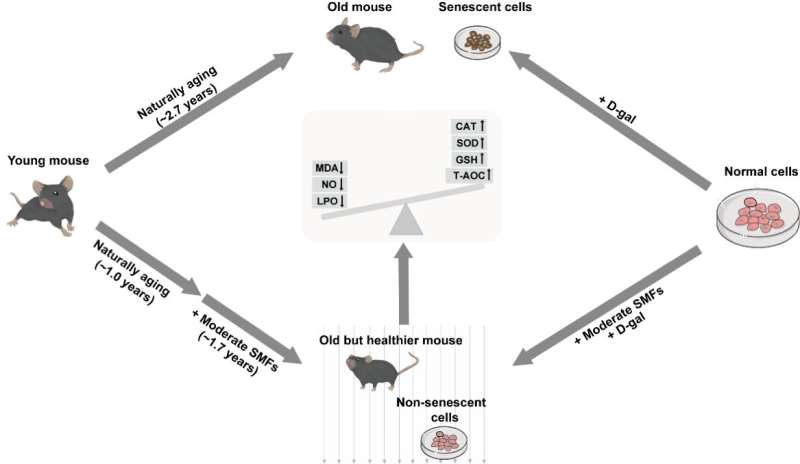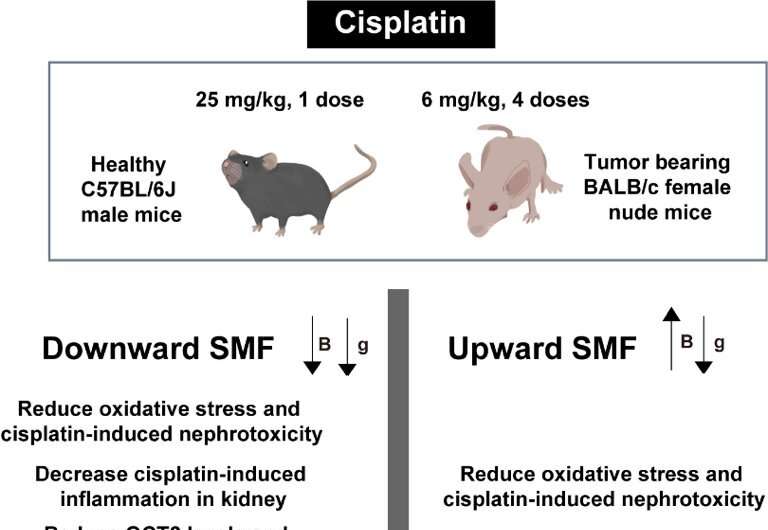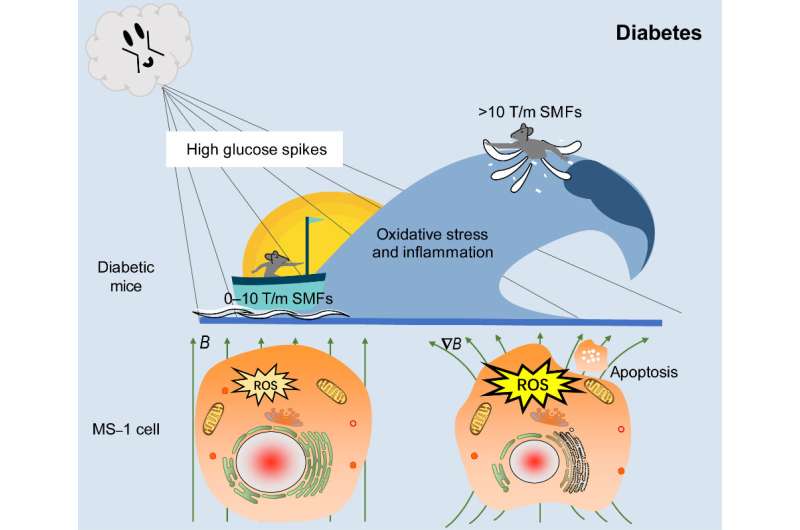This article has been reviewed according to Science X's editorial process and policies. Editors have highlighted the following attributes while ensuring the content's credibility:
fact-checked
peer-reviewed publication
trusted source
proofread
Studies reveal biosafety effects of moderate and high static magnetic fields

In three recent studies, Chinese researchers have delayed natural aging in healthy mice by continuous exposure to quasi-homogeneous static magnetic fields (SMFs) of moderate intensity, mitigated kidney damage induced by the chemotherapeutic drug cisplatin in mice, and investigated the harmful effects of high-gradient SMF exposure on mice with severe type 1 diabetes. Two studies have been published in the journal Antioxidants and one in Zoological Research.
Previously, the researchers, led by Prof. Zhang Xin from the Hefei Institutes of Physical Science of the Chinese Academy of Sciences (CAS), had explored the safety of high SMFs in healthy mice. No detectable adverse effects were found in healthy mice exposed to 3.5–23.0 T high SMFs for two hours or 7.0–33.0 T high SMFs for one hour, while potential beneficial effects on memory, cognition and antidepressant effects in mice were revealed. However, it remains unclear whether prolonged SMF exposure, and/or mice in different pathological states would pose safety issues.
They first exposed normal mice to a 0.1 T moderate quasi-uniform SMF delivered by a permanent magnet plate continuously for 1.7 years. Not only did it have no adverse effects, but it also improved their survival status, including the activity of behavior, and even delayed their natural aging process and extended their lifespan.

In addition, the same SMF also alleviated chronic kidney injury induced by the chemotherapeutic drug cisplatin in MDA-MB231 breast cancer tumor-bearing mice and ameliorated acute kidney injury induced by high dose cisplatin. Both studies were associated with reduced oxidative stress levels in cells and tissues induced by SMFs.
On the other hand, magnetic resonance imaging (MRI) techniques have been widely used for disease diagnosis, and higher SMF intensities have been crucial for improving MRI image quality. In fact, 9.4 T MRI has been tested in healthy volunteers, but its effects on diabetic patients were unknown. The researchers therefore investigated the effects of 1.0–9.4 T SMFs on two types of type 1 diabetes (T1D) and one type 2 diabetes (T2D) mice, including >10 T/m and 0–10 T/m. A prolonged magnetic field exposure of 14 hours was used to explore the upper limit of magnetic field safety.

The results showed that treatment with high gradient SMFs (1.0–8.6 T) for 14 hours produced some adverse effects in both T1D and T2D mice, including damage to spleen, liver and kidney tissues, as well as elevated levels of blood glucose, glycosylated serum proteins, inflammation and anxiety, whereas low gradient or quasi-uniform 0–10 T/m ~9.4 T high SMFs were safer and did not show the above phenomena.
In addition, they found that in the kidneys of T1D mice with blood glucose ≥16.7 mM, high SMFs with gradients >10 T/m increased tissue malondialdehyde levels and decreased superoxide dismutase levels. However, in severe T1D mice with glucose ≥30.0 mM, high SMFs with gradients >10 T/m not only significantly increased multi-organ damage but also decreased mice survival. In vitro cellular studies showed that gradient magnetic fields increased reactive oxygen levels in mice islet endothelial cells (MS-1), promoted apoptosis, and decreased cell proliferation.
These results suggest that exposure to gradient high magnetic fields >10 T/m (35–1,380 times higher than current clinical MRI) for 14 hours (significantly longer than clinical MRI) produced deleterious effects in diabetic mice, especially in severe T1D mice. In contrast, the ~9.4 T near-uniform high SMFs that were directly associated with MRI had no significant adverse effects, providing important information for the future development and clinical application of SMFs, especially for high-field MRI.
More information: Yixiang Fan et al, Life on Magnet: Long-Term Exposure of Moderate Static Magnetic Fields on the Lifespan and Healthspan of Mice, Antioxidants (2023). DOI: 10.3390/antiox12010108
Biao Yu et al, Effects of gradient high-field static magnetic fields on diabetic mice, Zoological Research (2023). DOI: 10.24272/j.issn.2095-8137.2022.460
Xin Yu et al, Static Magnetic Fields Protect against Cisplatin-Induced Kidney Toxicity, Antioxidants (2022). DOI: 10.3390/antiox12010073





















